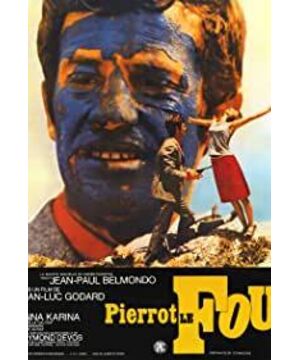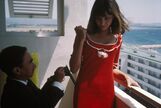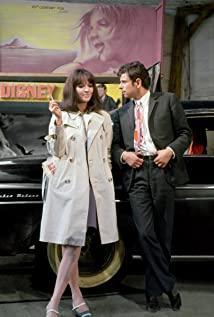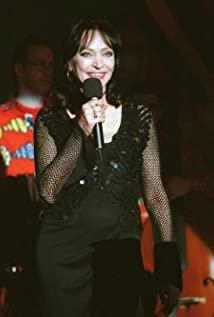The guest is Mr. Zhang Yeqi, a teacher of the Department of Radio, Film and Television, Northwestern University, Ph.D. in Drama and Film, Nanjing University
(May be different from what the teacher said)
Before talking about Pierrot the Madman, we need to put aside all moral factors and look at the characters, the story, and the theme. "Piero the Madman" is about "love". Love is complicated and vague, and it is also a topic on a philosophical level.
Godard was active during the French New Wave period, and his films are typical auteur's films. Godard studied anthropology, art history, music history before becoming a director. His other well-known film, Burnout, bears certain similarities to Pierrot the Madman, based on crime news. And Godard turned a real case into his own philosophical gloom and reflection on history through images. Godard, Truffaut, and Chabrol initially took the stage as film critics after Bazin's Cahier de la Cinéma. In 1980, Godard turned the history of cinema into a film.
Godard is the director and also the screenwriter. The hero is Jean Paul Belmondo and the heroine is Anna Karina, Godard's wife. The shots of Pierrot the Madman have no logical connection. Pierrot and Mariana are both people who think the future is far away. Mariana calls Ferdinand "Piero" and tries to define a new identity for Ferdinand. "Ferdinand" is the symbol of Ferdinand as a social man.
Godard turned the "camera into a fountain pen", freeing himself and unscrupulously. "Pierro the Madman" has the feeling of a visual oil painting. At that time, there was a school of oil painting in Godard's time, which used perspective and natural light effects to restore paintings to realistic scenes. Godard was inspired to shoot with natural light, and Ferdinand's opening monologue is Godard's cue to pay homage to the shooting of improvised films.
The language of the film ranges from Griffith to Eisenstein to Bazin's theory: shooting with long lenses, large depth of field and long distances, it is a documentary aesthetic, the sound and picture are synchronized, and it has a sense of presence. In this film, Godard did not care about all the existing audio-visual language, and used a lot of narration, voice-over, and soundtrack to integrate images from different time and space. He regards sound as a means of expression equal to image, which breaks the aesthetics of documentary and makes the story more puzzling. You can refer to Brecht's theory: the actor jumps out of identity. The images are in a coherent time and space, with unconscious personalities and conscious expressions. The plot ends anytime and anywhere, leaving the audience room for thinking.
Godard adopts a non-linear narrative, and his jump-connection is unique in the history of cinema. He is not concerned with the continuity of images and performances, leaving the audience at a loss in the "pieces". Truffaut's lens is a long stare and record. Eisenstein proposed a juggling montage, in which two images, the first image and the second image, collide with the chemical reaction of audio-visual language. Godard made a very precise deepening.
A story of murder, love, betrayal, human ego decadence, it's easy to point to a genre, but Godard doesn't. Balzac was a realist novelist whose novels condensed the living French society and history. Placing characters in typical forms in typical time and space and using personal experiences as metaphors of the times is the style of realistic novels. Godard redefines "realism", all the experiences in the film are incomprehensible, but the emotions and the inner world of the characters resonate strongly with the audience. What Godard expresses is "the reality I express", which is the alienation effect achieved by the collision of symbols.
Metz wrote in "Cinematic Semiotics" that the semiotics of the first stage, including all film languages, can be reduced to eight combinations, and "Pierro the Madman" bankrupted his theory because it could not be analyzed. Emotions are wild and frenetic, with randomness and contingency, so Metz had to add a ninth paragraph: the possibility paragraph.
Pierrot the Madman can be regarded as the "original text". When the content composition of a film or text passage (painting, sculpture, novel) is infinitely reset and referenced, we call it "original text". Godard made a new creation, even if the plot, protagonist, and story are repeated, he created a refreshing audio-visual language.
Godard has a very arrogant indifference and pessimism. He doesn't care whether the audience understands it or whether the hero is attractive. Ferdinand is a loser through and through. After the separation, Pierrot recognizes Mariana, but he is still like a teenager with his first love. The lunatic in the film has reconciled with himself, while Pierrot never looks back on himself.
The unselling, longest-running shots do the exact opposite. "It's so stupid. It's all pointless." And then there's the romantic ending and the ocean. Ferdinand is an image of a loser from start to finish, and we cannot judge with worldly eyes. Pierrot's death is a mockery of the desperate loss of love. Pierrot is not a hero, not a clown, his death is a meaningless death, a deeper indifference beyond tragedy and comedy.
Godard's bold colors, soundtracks, and editing are very post-modern, and can refer to Camus's view of the complete dissolution of meaning and the state of all emptiness. Godard's style is experimental, separates audio and video, and establishes three independent systems (two languages and subtitles). Blue represents melancholy and idiots. Godard uses audio-visual language contrast and irony to create an unprecedented video paradigm.
Godard's films are typical author films. The starting point for creating a film is a painting. He calls elements independently, color and light and shadow to change the original audio-visual rhythm. One of the passages expresses the tiredness of marriage and the numbness of people. It is a pop image, the art of reproduction in the mechanical age. The pop-up visuals suggest that Mariana and Ferdinand could be anyone.
A Clockwork Orange (mentioned by the audience) is not hallucinatory, continuous, and empty, boring time is not cut out. And "Pierro the Madman" is subjective and fragmented. There is no story, but an experience of emotions. A Clockwork Orange uses stylized techniques to reproduce the unreal subjective world and broken brain world of the hero, but it is still a closed audio-visual language. Pierrot the Madman has no rules and no logic. It is the aging and rigidity of a relationship, the breaking and reorganization of continuous events, the audience is still the identity of the other, the bystander, and everything is a seemingly complete time and space pieced together from the original shape of the world.
Godard used a de-dramatic approach, repeatedly using cross montages and contrast montages. "I don't use plots to tell stories, I use pictures." Angelopoulos also used blank, continuous, continuous, two-minute shots of walking in the snow to be long, lonely, fearful, dazed, and unfamiliar.
Facing Mariana, Pierrot didn't know how love could last forever, so he could only kill her with his own hands, and then kill himself. "It hurts so much", he is a person who is desperate for love and has no ability to fight. Not the emotion of classical tragedy, but the dissipation of value.
The value of literature and art lies in being able to constantly discover that the original values are vulgar and meaningless, that love and betrayal cannot be controlled, and people are people with life and passion, we must embrace and show and accept them. Modernity breaks away from its original shackles and shells.
View more about Pierrot le Fou reviews









